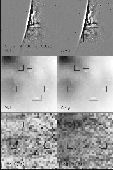
 |
Documentation > SXT Observation Notes > this page |
Image name: T_and_EM_effect_of_dark-pix.png (click image to enlarge)
Image size: 29.1160 KB (512x768)
Date submitted: 11-Apr-1997

EFFECT OF DARK PIXELS ON TEMPERATURE AND EMISSION MEASURES
Since the discovery of "dark" or radiation-damaged CCD pixels (see
CCD_DARK_PIXELS in show_pix/calibration) I've worried about how seriously
this problem effects temperature and emission measures derived from the
images. This is a preliminary analysis to check for gross and obvious
problems. The answer, at least for the two thin filters, is encouraging.
The effect on temperature appears to be smaller than other sources of
dispersion. The effect on emission measure is what one would expect -- the
derived emission measure in the dark pixels is less than adjacent
neighbors.
The FR pfi data are 20 frames of an over-the-limb active region observed
(first, last) = '15-JUL-96 00:11:53', '15-JUL-96 00:21:59' There were 7
Al.1 images and 13 AlMg images, all with the same ROI on the CCD. The
images were dark and leak corrected with SXT_PREP and summed. The top 2
frames of the figure are difference frames prepared with the commands
up2,(al-float(big_smooth(al,7,/noccd)))>(-3000)<3000
up2,(dg-float(big_smooth(dg,7,/noccd)))>(-6000)<6000.
I.e., a 9-point boxcar smoothed image has been subtracted to enhance the
dark pixels.
The indicated sub-image is displayed in the middle pair of pictures. Here
simple linearly scaled data are displayed. The dark pixels are still
evident but not so dominant. The mean signals in the sub-images are 1982
and 4560 per pixels for Al.1 and AlMg respectively. Five distinct dark
pixels are indicated by boxes.
Temperatures and emission measures have been derived from the summed images
with the command
sxt_teem,2,al,3,dg,t1=total(gt_expdur(iout(iial))), $
t2=total(gt_expdur(iout(iidg))),date=iout(0),te,em.
The log10(Te) and Log(EM) sub-images are displayed in the bottom panels.
The mean temperature and emission measure for this sub_image are 10^6.44
and 10^44.15 respectively. The locations of the dark pixels are indicated.
A cursory examination indicates no obvious correlation between dark pixels
and anomalous temperatures. This would suggest that for the thin filters
the proportional trapping of charge is about the same for the 2 thin
filters. There IS a correlation between dark pixels and low emission
measure -- as there should be.
L. Acton 11-April-97